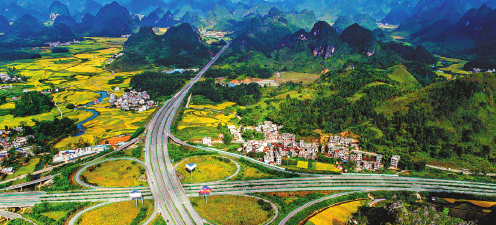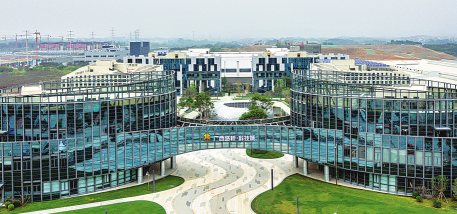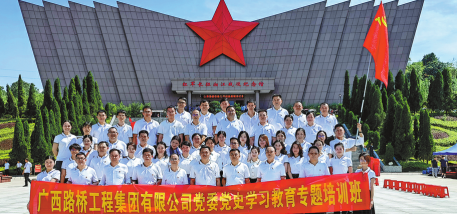Guangxi uses transport system to open up

The view of Jingna expressway. The Guangxi Zhuang autonomous region is one of China's first 13 pilot zones for the construction of an advanced transport system across the nation. CHINA DAILY
New additions set to drastically reduce travel time to local areas and major international cities alike
The Guangxi Zhuang autonomous region, one of China's first 13 pilot zones for the construction of an advanced transport system across the nation, will promote high-level opening-up of the region's transport system to the outside world, local officials said. It will also take advantage of the New International Land-Sea Trade Corridor, a trade and logistics passage jointly built by Singapore and provincial-level regions in western China.
Lu Xiaoming, deputy director of the Transportation Department of Guangxi, said: "Five key projects cover the construction of international gateway hubs, the facilitation of international transportation, the interconnection of information and the development of science and technology."
Guangxi recently issued the Plan for the Implementation of the Outline for Building a Strong Transportation Country, in which it will aim to build a multidirectional transport corridor shared by large-capacity railways and multichannel expressways.
In the next step, Guangxi will establish an open transportation system, deepen international cooperation and promote the construction of digital ports.

The Guangxi road and bridge technology center is a new landmark in Nanning. Guangxi Zhuang autonomous region. CHINA DAILY
It strives to build itself into a strong traffic area by the end of 2035 and form a "3213 travel traffic circle" in which people can reach major ASEAN cities in three hours, other cities in two hours, the Beibu Gulf city cluster in one hour and the metropolitan area in 45 minutes.
Guangxi is also constructing the"123 Express Cargo Flow Circle" to reach domestic regions in one day, ASEAN countries in two days and major cities across the world in three days.
The region will build a comprehensive transport corridor for land-sea linkage and east-west bidirectional passage.
A new land-sea channel in the west has been completed with a high level of openness to the outside world for transport.
The channel's service guarantee capacity can also meet the needs of regional economic and social development.
Nine railway channels and 18 expressway channels have been formed to provide multichannel access to the southwest and central-south regions, supporting Guangxi as an important gateway for connection under the Belt and Road Initiative.
According to the Guangxi Expressway Network Plan (2018-30), the region plans to increase the mileage of approximately 6,600 kilometers of expressways and 1,260 km of reconstruction and expansion.
The total length of expressways in Guangxi is expected to be 15,200 km by 2030.
Guangxi aims to build an expressway network with "interconnected multiple districts, converging cores, smooth outside and inside, fully connected, balanced, reliable and efficient", forming a "one ring, 12 horizontal, 13 vertical pattern and 25 connections". By 2030, the total scale of expressways in the region will be 15,200 kilometers, forming a highway network that connects the Guangdong-Hong Kong-Macao Greater Bay Area and the ASEAN region with trunk lines and branch lines connecting the Bay Area and the ASEAN region.
Among them, there are five major external channels connecting the southwest to the Bay Area, two external channels connecting the Changsha-Zhutan and the Yangtze River Delta, and five major external channels connecting the China-New Zealand southward.
By the end of the planning period, the Guangxi expressway network will have 20 new interprovincial passages, nine new border passages, and five new sea passages.
The number of provincial, border and sea passages will increase from 31 to 65.
The main expressway in the main direction is an expressway with eight lanes and above. A double-track dual-channel will be formed to meet the needs of regional interconnection and economic cooperation and development.
It will form a three-way expressway between Guilin-Liuzhou-Nanning region and coastal areas.
In addition, Guangxi will improve the efficiency of its road networks and enhance its ability to avoid risk.
The expressway connects important transportation hub nodes and major border ports, covering all key industrial parks, important scenic spots and 5A and 4A-level scenic spots.
"In the past, our lives were really difficult. To buy things in the town, we had to rely on manpower to carry the items to the river and transport them to the opposite bank by steel cables or ferry, which was very troublesome," said Wei Jiaqin, a villager in Longwan township, Du'an country.
"When the transportation department helped us build bridges and roads, our living conditions greatly improved." A number of road construction projects that directly benefit local people have been implemented, with 46 convenient village roads totaling 65 kilometers being built.
Guangxi has also launched the learning and education of the Party history.

Guangxi Road and Bridge Engineering Group launches a learning activity about the Party's history. CHINA DAILY














